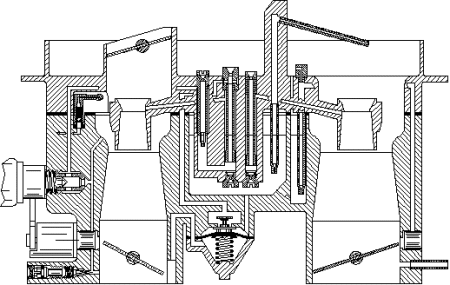
|
Two-barrel downdraught carburetor

Function
As a twin carburetor it makes individual fillings possible for each individual cylinder, which, due to mechanical differences, have an irregular intake. Thus each cylinder has, e.g., in a four cylinder engine with two register
carburetors, its own choke funnel.As a register carburetor (see above figure) it makes two, generally different sized choke funnels available for all the cylinders. The smaller one provides the ideal mixture formation in
the lower partial load area and the larger, in the upper partial load- and full throttle area. Thus the register carburetor was also called the two-phase carburetor.
How it works
In the twin carburetor each choke funnel is equipped with all functions, except for the float chamber, of which there is only one. Just as the single carburetor can be compared more
with the central injection, the twin carburetor (or, e.g., in the six-cylinder engine, the triple carburetor) could be
compared with the multi-point-injection. Twin carburetors are, because of their mounting position close to
the engine, generally side-draught carburetors, register carburetors are generally down-draught.
Due to the fact that in the register carburetor, both choke funnels are connected with all the cylinders, its functions are divided: Cold starting, idling, transition and acceleration for the first phase (see figure on the left),
and full throttle for the second phase. Additionally, there is, exactly like in the first phase, an electrically heated transitional slot which enables the second phase to gently come into action. In contrast to the dual
carburetor, the throttle flaps open one after the other, either mechanically or through vacuum.In the further development there was also the combination of a twin carburetor and a register carburetor with a total of four
choke funnels, this however, was for engines with at least six cylinders.

Triple
downdraught carburetor Porsche 911s
Important
Multiple carburetors must be synchronised, so that they can be evenly controlled by the accelerator pedal. Apart from a multiple vacuum-manometer, a lot of intuition and experience is necessary for the adjustment. The
rewards are, a higher performance yield, distinctly better response and lower fuel consumption. 12/09
|
|